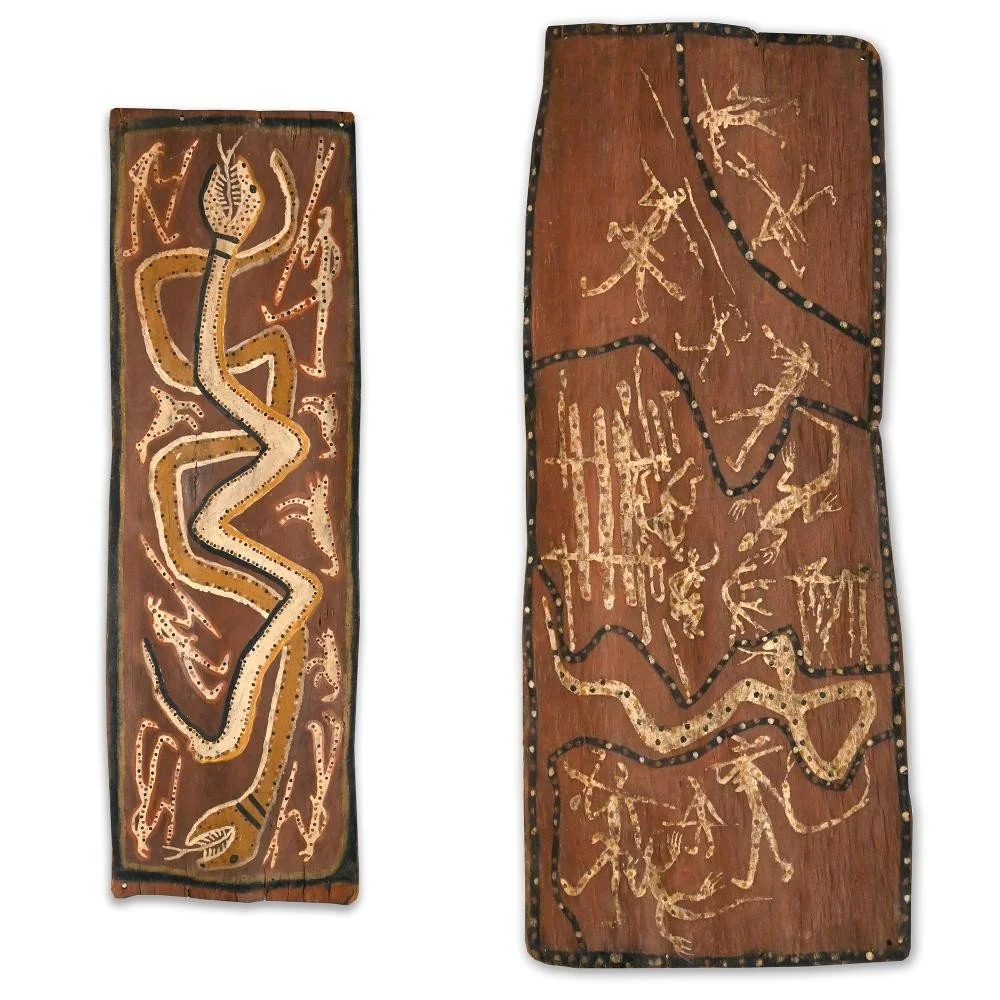
Artist: Tom Djumburpur | Title: Wagilag Sisters Story | Year: 1982 | Medium: natural earth pigments on bark | Dimensions: 155cm x 76cm
PROVENANCE
Bula Bula Arts Ramingining NT Cat No. O-729-ORR
Private Collection
Cooee Art Gallery, Sydney NSW
EXHIBITED
Bark Paintings 1930-2000, July 2011, Cooee Art Gallery, Sydney
ARTWORK STORY
The painting shows two pythons, Julunggul, who appear in the sacred Wagilag Sisters Story. The Wagilag are two sisters who travelled from south Arnhem Land (the Roper River area), eventually reaching a sacred waterhole or well in which, unknown to them, the python Julunggul lived. The foods which they caught and collected, when placed on a fire, jumped up and disappeared into the waterhole. When one of the sisters gave birth to a baby, Julunggul smelt the afterbirth blood. Disturbed by this and by all the creatures jumping into his waterhole, the monstrous python emerged and swallowed the two sisters and the child. According to one version of the story, this symbolised the onset of the monsoon season. Later he vomited them up.
Artist Profile
COMMUNITY/REGION
Ramingining, Central Arnhem Land, NT
LANGUAGE
Yolngu (Djinba and Wudamin)
BIOGRAPHY
Born in 1920 in Djilpin, near the Goyde River, Tom Djumburpur lived a traditional lifestyle with his family before joining the mission at Ramingining. He was initiated at Murrwangi and learned the art of painting from his second father, Charlie Wagirr.
Djumburpur's work often depicted the Wagilag Sisters' creation myth and sacred themes, rendered with traditional ochres and fine cross-hatching (rarrk). He contributed to the Aboriginal Memorial (1998) - first exhibited at the Biennial of Sydney and now permanently housed at the National Gallery of Australia - where he carved and painted log coffins as part of a significant installation commemorating the impact of European settlement on Indigenous peoples.
REFERENCES
Australian Prints + Printmaking. Tom Djumburpur.
QAGOMA. Tom Djumburpur.
National Gallery of Australia. Tom Djumburpur.
PROVENANCE
Bula Bula Arts Ramingining NT Cat No. O-729-ORR
Private Collection
Cooee Art Gallery, Sydney NSW
EXHIBITED
Bark Paintings 1930-2000, July 2011, Cooee Art Gallery, Sydney
ARTWORK STORY
The painting shows two pythons, Julunggul, who appear in the sacred Wagilag Sisters Story. The Wagilag are two sisters who travelled from south Arnhem Land (the Roper River area), eventually reaching a sacred waterhole or well in which, unknown to them, the python Julunggul lived. The foods which they caught and collected, when placed on a fire, jumped up and disappeared into the waterhole. When one of the sisters gave birth to a baby, Julunggul smelt the afterbirth blood. Disturbed by this and by all the creatures jumping into his waterhole, the monstrous python emerged and swallowed the two sisters and the child. According to one version of the story, this symbolised the onset of the monsoon season. Later he vomited them up.
Artist Profile
COMMUNITY/REGION
Ramingining, Central Arnhem Land, NT
LANGUAGE
Yolngu (Djinba and Wudamin)
BIOGRAPHY
Born in 1920 in Djilpin, near the Goyde River, Tom Djumburpur lived a traditional lifestyle with his family before joining the mission at Ramingining. He was initiated at Murrwangi and learned the art of painting from his second father, Charlie Wagirr.
Djumburpur's work often depicted the Wagilag Sisters' creation myth and sacred themes, rendered with traditional ochres and fine cross-hatching (rarrk). He contributed to the Aboriginal Memorial (1998) - first exhibited at the Biennial of Sydney and now permanently housed at the National Gallery of Australia - where he carved and painted log coffins as part of a significant installation commemorating the impact of European settlement on Indigenous peoples.
REFERENCES
Australian Prints + Printmaking. Tom Djumburpur.
QAGOMA. Tom Djumburpur.
National Gallery of Australia. Tom Djumburpur.






